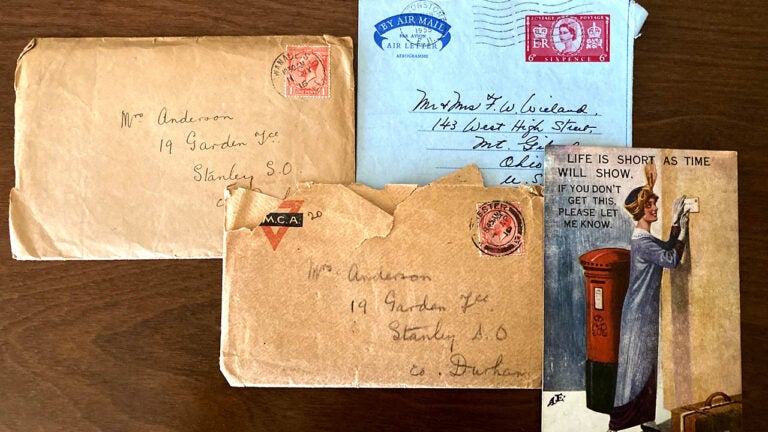
Yellowed, folded letter pages make history lessons tangible
Getting a letter in the mail, looking at its postmarks, the thickness and color of the paper, the handwriting of the sender — there is no substitute for this tactile experience. Wanting to give students in her “Twentieth Century Britain” course something tangible in a time when nearly all interactions are virtual, Lindsay O’Neill decided to send them physical correspondence from people living in earlier eras.
“One of the things I really enjoy doing with my classes is allowing them to interact with rare materials,” said O’Neill, associate professor (teaching) of history at the USC Dornsife College of Letters, Arts and Sciences. “When I sat down to think about how to do this in our online format, I was inspired by [Professor (Teaching) of History] Deb Harkness, who had mailed her students historical objects in the spring.”
Like Harkness, O’Neill went on eBay to find historical materials she could send to students. She ended up with a set of letters dating from 1954 to ’55, between a Chinese woman in London and a woman in Ohio. The woman from London was hoping to emigrate to the U.S., and most of the letters revolved around that topic.
To obtain her next set of letters, O’Neill went to USC Libraries’ Special Collections, where Exile Studies Librarian Michaela Ullmann steered her toward a friend: Jennifer Johnson of Johnson Rare Books and Archives in Covina, California. Johnson had heard about Harkness’s project and managed to find O’Neill a good bargain on some letters dating back to World War I, between a woman and her husband, who was serving as a soldier. Most of these letters, obviously, concerned the war.
Noah Hellum, a senior history major, received a letter from the World War I soldier to his wife that was dated Dec. 19, 1917. He noted that there were actually two letters involved: one subject to government censorship and one that was not. The censored one was brief and mentioned some small gifts she had sent him. The uncensored one, however, was more emotional and expressed deeper and more romantic feelings toward his spouse. The censored letter was in a white envelope, and the uncensored one was in a green envelope, per the rules for correspondence during the war.
O’Neill said this sort of physicality gave the documents additional layers of meaning.
“I want my students to examine not just the words in the letters but the paper the letters were written on. For example, the paper gets worse the more the soldier moved around and paper became scarce, and the 1950s letters were on these blue air mail papers that could be folded up into an envelope,” she said.
Hellum agreed that having the physical objects to handle was very different from just looking at an online scan or transcription.
“Unfolding the sepia-toned letters was both exciting and nerve-wracking,” he said, his voice rising with enthusiasm. “In your hands, you have monumental moments of someone’s life. You have to treat those documents with respect to honor the gift you have received of telling that person’s story,” he said.
The students transcribed the letters into a shared google doc as part of their midterm, and for their final project, they wrote a paper based on some aspect of the letters. This could include their content or a related topic, such as the postal service at the time or the events in London in the mid-20th century.
O’Neill said she hopes the exercise gave her students a new or heightened appreciation of historical objects.
“It’s an interesting look at how the materiality of an object matters. The nature of the paper, what the paper looks like — all of this affects how you use it, and it’s one of the things I hope they get out of the experience.”